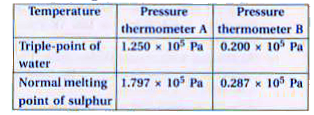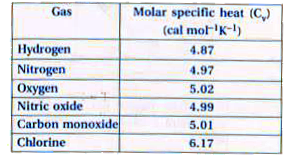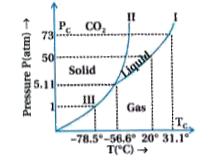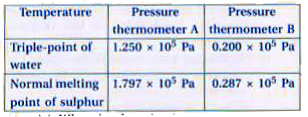Section - B (Numericals) Numerical From Textual Exercise (Answer the following : ) from KUMAR PRAKASHAN KENDRA PHYSICS (GUJRATI ENGLISH) THERMAL PROPERTIES OF MATTER for Class 11
| Class 11 | PHYSICS |
| Chapter | THERMAL PROPERTIES OF MATTER |
| KUMAR PRAKASHAN KENDRA PHYSICS (GUJRATI ENGLISH) | Section - B (Numericals) Numerical From Textual Exercise (Answer the following : ) |
| Medium | English |
| Academic Year | 2023-2024 |
Question 3
A sphere of aluminium of 0.047 kg placed for sufficient time in a vessel containing boiling water, so that sphere is at 100 ∘C. It is then immediately transferred to 0.14 kg copper calorimeter containing 0.25 kg of water at 20 ∘C. The temperature of water rises and attains a steady state at 23 ∘C. Calculate the specific heat capacity of aluminium.View SolutionQuestion 5
Calculate the heat required to convert 3 kg of ice at −12 ∘C kept in a calorimeter to steam at 100 ∘C at atmospheric pressure. Given specific heat capacity of ice =2100 J kg−1K−1, specific heat capacity of water =4186 J kg−1K−1, latent heat of fusionn of ice =3.35×105 J kg−1 and latent heat of steam =2.256×106 J kg−1. View SolutionQuestion 6
What is the temperature of the steel-copper junction is the steady state of the system shown in figure. Length of the steel rod = 15.0 cm, length of the copper rod = 10.0 cm, temperature of the furnace =300∘C, temperature of the other end =0∘C. The area of cross section of the steel rod is twice that of the copper rod. (Thermal conductivity of steel =50.2 Js−1m−1K−1, and copper =385 Js−1m−1KJ−1).
 View Solution
View SolutionQuestion 7
An iron bar (L1=0.1 m,A1=0.02 m2,K1=97 Wm−1K−1) and a brass bar (L2=0.1 m,A2=0.02 m2,K2=109 W m−1K−1) are soldered end to end as shown in figure. The free ends of the iron bar and brass bar are maintained at 373 K and 273 K respectively. Obtain expressions for and hence compute (i) the temperature of the junction of the two bars, (ii) the equivalent thermal conductivity of the compound bar, and (iii) the heat current through the compound bar.
 View Solution
View SolutionQuestion 12
A sphere of aluminium of 0.047 kg placed for sufficient time in a vessel containing boiling water, so that sphere is at 100 ∘C. It is then immediately transferred to 0.14 kg copper calorimeter containing 0.25 kg of water at 20 ∘C. The temperature of water rises and attains a steady state at 23 ∘C. Calculate the specific heat capacity of aluminium.View SolutionQuestion 14
(a) How much heat should be provided to ice of 720 g mass, lying at -10∘C to melt it to water at 0∘C ? (b) How much heat should be provided to water at 0∘C to increase its temperature to 100∘C ?(c) How much heat should be given to water at 100∘C to transform it completely into water ?
(d) Totally, how much heat should be given to ice of 720 g at −10∘C to convert it completely into vapour ? (C"ice"=2220 "J kg"^(-1) K^(-1), C"water"=4190 "J kg"^(-1) K^(-1) , LF=333 "kJ"/"kg", LV=2256 "kJ"/"kg")View SolutionQuestion 15
What is the temperature of the steel - copper junction in the steady state of the system shown in Fig. Length of the steel rod = 15.0 cm, length of the copper rod = 10.0 cm, temperature of the furnace =400 ∘C, temperature of the other end =0 ∘C. The area of cross section of the steel rod is twice that of the copper rod.
(Thermal conductivity of steel =50.2 J s−1m−1K−1, and of copper =385 J s−1m−1 K−1).
 View Solution
View SolutionQuestion 16
What is the temperature of the aluminium junction in the steady state of the system shown in Fig. Length of the load =15.0 cm, length of the aluminium rod =10.0 cm temperature of the furnace = 400 ∘C, temperature of the other end =0 ∘C. The area of cross section of the lead rod is twice that of the aluminium rod.
(Thermal conductivity of steel =34.9 J s−1m−1K−1, and copper =205 J s−1m−1 K−1)
 View Solution
View SolutionQuestion 21
The electrical resistance in ohms of a certain thermometer varies with temperature according to the approximate law :
R=R0[1+α(T−T0)]
The resitance is 101.6 Ω at the triple-point of water 273.16 K, and 165.5 Ω at the normal melting point of lead (600.5 K). What is the temperature when the resistance is 123.4 Ω ? View SolutionQuestion 23
There were two fixed points in the original Celsius scale which were assigned the number 0∘C and 100∘C respectively. On the absolute scale, one of the fixed point is the triple - point of water, which on the Kelvin absolute scale is assigned the number 273.16 K. What is the other fixed point on this (Kelvin) scale ? View SolutionQuestion 27
Two ideal gas thermometers A and B use oxygen and hydrogen respectively. The following observations are made :

What do you think is the reason behind the slight difference in answers of thermometers A and B ? (The thermometers are not faulty). What further procedure is needed in the experiment to reduce the discrepancy between the two readings ? View SolutionQuestion 28
A steel tape 1 m long is correctly calibrated for a temperature of 27.0∘C. The length of a steel rod measured by this tape is found to be 63.0 cm on a hot day when the temperature is 45.0∘C. What is the actual length of the steel rod on that day ? What is the length of the same steel rod on a day when the temperature is 27.0∘C ? Coefficient of linear expansion of steel =1.20×10−5K−1. View SolutionQuestion 29
A large steel wheel is to be fitted on to a shaft of the same material. At 27∘C, the outer diameter of the shaft is 0.70 cm and the diameter of the central hole in the wheel is 8.69 cm. The shaft is cooled using 'dry ice'. At what temperature of the shaft does the wheel slip on the shaft ? Assume coefficient of linear expansion of the steel to be constant over the required temperature range :
αsteel=1.20×10−5K−1. View SolutionQuestion 32
A brass rod of length 50 cm and diameter 3.0 mm is joined to a steel rod of the same length and diameter. What is the change in length of the combined rod at 250∘C, if the original lengths are at 40.0∘C ? there a 'thermal stress' developed at the junction ? The ends of the rod are free to expand (Coefficient of linear expansion of brass =2.0×10−5K−1, steel =1.2×10−5K−1).View SolutionQuestion 34
A 10 kW drilling machine is used to drill a bore in a small aluminium block of mass 8.0 kg. How much is the rise in temperature of the block in 2.5 minutes, assuming 50% of power is used up in heating the machine itself or lost to the surroundings. Specific heat of aluminium =0.91 Jg−1K−1. View SolutionQuestion 36
In an experiment on the specific heat of a metal, a 0.20 kg block of the metal at 150∘C is dropped in a copper calorimeter (of water equivalent 0.025 kg) containing 150 cm3 of water at 27∘C. The final temperature is 40∘C. Compute the specific heat of the metal. If heat losses to the surroundings are not negligible, is your answer greater or smaller than the actual value for specific heat of the metal ? View SolutionQuestion 37
Given below are observations on molar specific heats at room temperature of some common gases.

The measured molar specific heats of these gases are markedly different from those for monatomic gases. Typically, molar specific heat of a monatomic gas is 2.92 cal/mol K. Explain this difference. What can you infer from the somewhat larger (than the rest) value for chlorine ? View SolutionQuestion 38
Answer the following questions based on the P-T phase diagram of carbon dioxide :
(a) At what temperature and pressure can the solid, liquid and vapour phases of CO2 coexist in equilibrium ?
(b) What is the effect of decrease of pressure on the fusion and boiling point of CO2 ?
(c) What are the critical temperature and pressure for CO2 ? What is their significance ?
(d) Is CO2 solid, liquid or gas at (a) −70∘C under 1 atm, (b) −60∘C under 10 atm, (c) 16∘C under 56 atm ?
 View Solution
View SolutionQuestion 39
Answer the following questions based on the P - T phase diagram of CO2 :
(a) CO2 at 1 atm pressure and temperature −60∘C is compressed isothermally. Does it go through a liquid phase ?
(b) What happens when CO2 at 4 atm pressure is cooled from room temperature at constant pressure ?
(c) Describe qualitatively the changes in a given mass of solid CO2 at 10 atm pressure and temperature −65∘C as it is heated up to room temperature at constant pressure.
(d) CO2 is heated to a temperature 70∘C and compressed isothermally. What changes in its properties do you expect to observe ?
 View Solution
View SolutionQuestion 40
A child running a temperature if 101∘F is given an antipyrine (i.e. a medicine that lowers fever) which causes an increase in the rate of evaporation of sweat from his body. If the fever is brought down to 98∘F in 20 min, what is the average rate of extra evaporation caused, by the drug. Assume the evaporation mechanism to be the only way by which heat is lost The mass of the child is 30 kg. The specific heat of human body water, and latent heat of evaporation of water at that temperature is about 580 cal g−1. View SolutionQuestion 41
A 'thermacole' icebox is cheap and efficient method for storing small quantities of cooked food in summer in particular. A cubical icebox of side 30 cm has a thickness of 5.0 cam if 4.0 kg of ice is put in the box, estimate the amount of ice remaining after 6 h. The outside temperature is 45∘C, and coefficient of thermal conductivity of thermacole is 0.01 Js−1m−1K−1. [Heat of fusion of water =335×103 Jkg−1 ]View SolutionQuestion 42
A brass boiler has a base of 0.15m2 and thickness 1.0 cm. It boils water at the rate of 6.0 kg/min when placed on a gas stove. Estimate the temperature of the part of the flame in contact with the boiler. Thermal conductivity of brass =109 Js−1m−1K−1, Heat of vaporization of water =2256×103 Jkg−1. View SolutionQuestion 45
Explain why,
an optical pyrometer (for measuring high temperatures) calibrated for an ideal black body radiation gives too low a value for the temperature of a red hot iron piece in the open, but gives a correct value for the temperature when the same piece is in the temperature when the same piece is in the furnace. View SolutionQuestion 50
Two rods, one of iron and another of aluminium of equal length and equal cross-sections are connected with each other. The free end of the iron rod is kept at 100 ∘C and the free end of aluminium rod is kept at 0 ∘C. If thermal conductivity of aluminium is four times that of iron, find the temperature of their contact surface in the thermal steady state. View SolutionQuestion 55
Average temperature of the Earth was 300 K when the Earth came into existence. At present its average temperature is 3000 K (This is due to the heat evolving from the disintegration of radioactive substances at the core of the Earth) What would be the radius of the Earth at the toime of its birth ? For the material of the Earth γ=3×10−5K−1. At present, radius of the Earth = 6400 km. View Solution
All Exercises from KUMAR PRAKASHAN KENDRA PHYSICS (GUJRATI ENGLISH) Class 11 PHYSICS THERMAL PROPERTIES OF MATTER
- INFORMATION : HIGHER ORDER THINKING SKILLS (HOTS)
- SECTION - A QUESTIONS-ANSWER
- TRY YOURSELF (VSQS)
- SECTION - B
- SECTION - B (NUMERICALS) NUMERICAL FROM TEXTUAL EXERCISE
- SECTION - B (NUMERICALS) NUMERICAL FROM TEXTUAL EXERCISE (ANSWER THE FOLLOWING : )
- SECTION - B (NUMERICALS) NUMERICAL FROM TEXTUAL ILLUSTRATION
- SECTION - B NUMERICAL FROM .DARPAN. BASED ON TEXTBOOK
- SECTION - C OBJECTIVE QUESTIONS (VSQS)
- SECTION - C OBJECTIVE QUESTIONS (VSQS) ARE THE FOLLOWING STATEMENTS TRUE OR FALSE ?
- SECTION - C OBJECTIVE QUESTIONS (VSQS) ASSERTION AND REASON TYPE QUESTIONS
- SECTION - C OBJECTIVE QUESTIONS (VSQS) FILL IN THE BLANK
- SECTION - C OBJECTIVE QUESTIONS (VSQS) MATCH TYPE QUESTIONS
- SECTION - D NCERT EXEMPLAR SOLUTION (LONG ANSWER TYPE QUESTIONS )
- SECTION - D NCERT EXEMPLAR SOLUTION (MULTIPLE CHOICE QUESTIONS MCQS)
- SECTION - D NCERT EXEMPLAR SOLUTION (MULTIPLE CHOICE QUESTIONS MCQS) MORE THAN ONE OPTIONS
- SECTION - D NCERT EXEMPLAR SOLUTION (SHORT ANSWER TYPE QUESTIONS )
- SECTION - D NCERT EXEMPLAR SOLUTION (VERY SHORT ANSWER TYPE QUESTIONS )
- SECTION - E MULTIPLE CHOICE QUESTIONS (MCQS)
- SECTION - F QUESTION FROM MODULE (SAMPLE QUESTIONS FOR PREPARATION OF COMPETITIVE EXAMS)
- QUESTION PAPER (SECTION - A) ANSWER FOLLOWING IN ONE SENTENCE : (WORD LIMIT OF ANSWER IS 10) (EACH QUESTION CARRIES 1 MARK)
- QUESTION PAPER (SECTION - B) ANSWER THE FOLLOWING QUESTION IN SHORT : (WORD LIMIT OF ANSWER IS 10) (EACH CARRY 2 MARK)
- QUESTION PAPER (SECTION - C) DO AS DIRECTED : (WORD LIMIT OF ANSWER IS 10) (EACH CARRY 3 MARK)
- QUESTION PAPER (SECTION - D) (ANSWER FOLLOWING IN BRIEF :) EACH CARRY 4 MARKS


